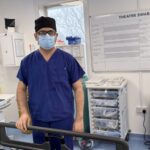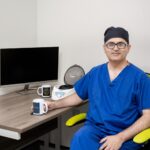
Breast Asymmetry Correction | Surgical Options That Work
Breast asymmetry, where one breast differs in size, shape, or position compared to the other, is a condition that affects a significant number of women. While slight differences are normal and common, noticeable asymmetry can sometimes create self-consciousness, affect how clothing fits, and impact overall body confidence.
For many women, this imbalance goes beyond aesthetics and can influence their comfort in swimwear, professional attire, and everyday clothing.
At Mr M Cheema’s Birmingham clinic, we understand that each patient’s needs are unique. Our approach to breast asymmetry correction is both safe and personalized, combining surgical expertise with advanced techniques to restore balance, enhance breast shape, and boost self-esteem.
Every procedure is tailored to your anatomy, lifestyle, and aesthetic goals, ensuring results that look natural and harmonious.
In this comprehensive guide, we will explore the underlying causes of breast asymmetry, the various surgical options available, what to expect during the consultation and preparation phase, and key recovery guidelines.
Understanding Breast Asymmetry
Breast asymmetry is a common condition that can affect women of all ages. It occurs when one breast differs from the other in size, shape, position, or overall appearance. While mild differences are natural and usually go unnoticed, more pronounced asymmetry can affect self-confidence, clothing fit, and overall body image.
There are several factors that can contribute to breast asymmetry. Genetics often play a role, influencing the natural size and shape of each breast. Hormonal changes during puberty, pregnancy, or menopause can also cause differences in breast volume or tissue density. Additionally, developmental factors during adolescence may lead to uneven breast growth.
Other contributing factors include pregnancy and breastfeeding, which can alter breast shape and volume differently in each breast. Significant weight fluctuations can also affect the size and contour of the breasts, as can previously breast surgeries or trauma to breast tissue.

Types of Breast Asymmetry
- Differences in overall breast size or volume: One breast appears larger or smaller than the other.
- Variations in breast shape and projection: Differences in roundness or contour.
- Uneven nipple position or orientation: Nipples may sit higher, lower, or point in different directions.
- Discrepancies in skin elasticity and firmness: One breast may appear looser or sag more than the other.
Understanding the specific type and degree of asymmetry is a crucial first step in determining the most effective corrective approach.
Surgical Options for Breast Asymmetry Correction
Correcting breast asymmetry requires a personalized approach that considers the size, shape, and overall anatomy of each breast. At Mr M Cheema’s Birmingham clinic, we offer a range of surgical options designed to restore balance, enhance contours, and achieve natural-looking results. The choice of procedure depends on the degree of asymmetry, skin quality, and the patient’s aesthetic goals.
1. Breast Augmentation
Breast augmentation is one of the most common solutions for asymmetry caused by a smaller breast. This procedure involves placing an implant in the smaller breast to match the size and shape of the larger breast. Implants come in different types, such as silicone, saline, and gummy bear, each with unique benefits in terms of feel, durability, and shape.
Mr Cheema carefully evaluates your body proportions, lifestyle, and desired outcome to select the most suitable implant type, size, and placement. Breast augmentation ensures a balanced, natural appearance while enhancing overall curves.
2. Breast Reduction
In cases where one breast is significantly larger, breast reduction surgery can create symmetry by removing excess tissue and skin. This not only improves appearance but also alleviates physical discomfort caused by uneven breast weight, such as back, neck, or shoulder pain. Reduction can be combined with shaping techniques to ensure both breasts have similar contour and projection, resulting in a harmonious and proportionate look.

3. Breast Lift (Mastopexy)
A breast lift addresses sagging and positional differences between breasts. By removing excess skin and reshaping the breast tissue, a lift can elevate drooping breasts and reposition the nipple to a more youthful location. This procedure is often performed in combination with augmentation or reduction to achieve optimal symmetry, improve overall breast contour, and restore a natural, balanced appearance.
4. Fat Grafting
Fat grafting, also known as fat transfer, is a minimally invasive technique for correcting mild asymmetry. This method uses the patient’s own body fat, typically harvested through liposuction, which is purified and injected into the smaller breast.
Fat grafting provides a natural feel, smooth contours, and subtle volume enhancement without the need for implants. It is especially suitable for patients who prefer a more organic approach to achieving symmetry.
5. Combination Procedures
For many patients, the most effective solution involves a combination of procedures. For example, a smaller breast may undergo augmentation while the larger breast is lifted or reduced. Combination procedures allow precise adjustment of size, shape, and nipple position, resulting in a balanced, symmetrical, and aesthetically pleasing outcome.
At Mr Cheema’s clinic, each combination plan is customized to match the patient’s anatomy and goals, ensuring natural-looking results with long-lasting benefits.
By selecting the appropriate surgical approach, patients can achieve enhanced symmetry, improved body proportions, and a boost in confidence. A detailed consultation with Mr Cheema is essential to determine the best method for everyone.
Transform Your Confidence Today
Take the first step toward balanced and beautiful breasts. Schedule a personalized consultation with Mr M Cheema and explore the surgical options that best suit your body and goals.

Choosing the Right Procedure
Selecting the most suitable procedure for breast asymmetry correction depends on several factors, including the degree of size difference, breast shape, skin quality, and your personal aesthetic goals. During your consultation at Mr M Cheema’s Birmingham clinic, a comprehensive evaluation will be conducted to understand your specific needs.
Some key considerations include:
Degree of asymmetry
Mild asymmetry may be corrected with fat grafting, while more pronounced differences might require implants, reduction, or a combination of procedures.
Breast size and shape
The existing volume and projection of your breasts help determine whether augmentation, reduction, or lifting techniques are necessary.
Skin elasticity and firmness
Loose or sagging skin may require a breast lift to ensure a youthful and balanced contour.
Desired aesthetic outcome
Some patients prioritize subtle symmetry and natural appearance, while others may also want enhancement or reshaping to complement overall body proportions.
Mr Cheema emphasizes individualized treatment planning, ensuring that the selected procedure aligns with your anatomy, lifestyle, and long-term goals. The right approach ensures natural-looking, harmonious results that boost confidence and body image.
Preparing for Surgery
Proper preparation is essential for a smooth surgical experience and successful recovery. Before undergoing breast asymmetry correction, it is important to:
List your goals and expectations
Clearly define what you want to achieve, including size, shape, and symmetry preferences.
Review medical history
Discuss previous surgeries, current medications, allergies, and any underlying health conditions with your surgeon.
Ask questions
Understand your procedure options, recovery timeline, potential risks, and expected results.
Follow preoperative instructions
Mr Cheema will provide guidelines such as medication adjustments, fasting, and lifestyle recommendations to ensure your safety.
Taking the time to prepare for surgery allows you to approach the procedure with confidence and ensures that the surgical plan is tailored specifically to your needs.
Recovery and Aftercare
Healing after breast asymmetry correction is a critical part of achieving optimal results. Recovery varies depending on the type of procedure performed, your overall health, and adherence to post-operative instructions. Key recovery tips include:
Supportive garments
Wearing the recommended surgical bra provides gentle compression, reduces swelling, and supports the healing tissues while helping the breasts settle into their new shape.
Activity restrictions
Avoid strenuous exercise, heavy lifting, or high-impact activities for several weeks. Light walking is encouraged to promote circulation and prevent complications.
Pain management and wound care
Follow Mr Cheema’s instructions carefully to manage discomfort, protect incisions, and prevent infection.
Hydration and nutrition
Eating a balanced diet rich in protein, vitamins, and minerals aids tissue repair and accelerates healing.
Follow-up appointments
Regular check-ins allow your surgeon to monitor progress, address concerns, and ensure results are developing as expected.
Swelling and bruising are normal during the first few weeks and gradually subside. Final results usually become apparent over several months as the breasts settle into their new contours. Patience and adherence to aftercare instructions are essential for long-lasting and natural-looking outcomes.
Risks and Considerations
While breast asymmetry correction is generally safe, it is important to be aware of potential risks and factors that may affect your results. Understanding these considerations helps patients make informed decisions and ensures a smoother recovery process.
Some risks associated with breast asymmetry correction include:
Infection
Although rare, infections can occur at the incision site. Following proper wound care and hygiene instructions reduces this risk.
Bleeding or hematoma
Accumulation of blood under the skin may require medical attention, but careful surgical techniques minimize this possibility.
Scarring
Incisions will leave scars, though Mr Cheema uses advanced techniques to place them in discreet locations. Scars typically fade over time.
Changes in nipple or breast sensation
Temporary or, in rare cases, permanent changes in sensation can occur after surgery.
Implant-related complications
For patients receiving implants, there is a small risk of rupture, shifting, or capsular contracture. Choosing the right implant type and following aftercare instructions reduces these risks.
Residual asymmetry
While the goal is optimal balance, slight differences may persist, particularly in cases with significant pre-existing asymmetry.
By choosing an experienced surgeon like Mr M Cheema, patients significantly reduce these risks and increase the likelihood of achieving safe, natural, and long-lasting results.
Why Choose Mr M Cheema for Breast Asymmetry Correction
Mr M Cheema is a trusted plastic surgeon in Birmingham, renowned for his expertise in breast surgery and personalized patient care. Choosing Mr Cheema ensures:
- A customized surgical plan tailored to your body type and aesthetic goals.
- Expertise in augmentation, reduction, lift, fat grafting, and combination procedures.
- Focus on patient safety, comfort, and natural-looking outcomes.
- Comprehensive support and guidance throughout the consultation, surgery, and recovery process.
With Mr Cheema, patients can achieve balanced, symmetrical breasts and enjoy enhanced confidence and body harmony.
Your Path to Symmetrical and Natural-Looking Breasts
Breast asymmetry correction is more than a cosmetic procedure; it is an opportunity to restore confidence, improve body proportions, and feel comfortable in your own skin. Whether through augmentation, reduction, lift, fat grafting, or a combination of techniques, the key to success lies in careful planning, expert surgical execution, and attentive post-operative care.
At Mr M Cheema’s Birmingham clinic, every patient receives a tailored approach to breast asymmetry correction, ensuring results that are safe, natural, and long-lasting. If you are considering correcting breast asymmetry, schedule a consultation with Mr Cheema today to discuss your goals and explore the best surgical options for your body.
Achieve Safe and Lasting Results
Your safety and satisfaction are our top priorities. At Mr M Cheema’s Birmingham clinic, we combine advanced techniques with personalized care to ensure natural-looking, long-lasting results.
Frequently Asked Questions
What causes breast asymmetry?
Breast asymmetry can be caused by genetics, hormonal changes, puberty, pregnancy, breastfeeding, weight fluctuations, or previous surgeries. Minor differences are normal, but noticeable asymmetry can affect appearance and confidence.
Who is a good candidate for breast asymmetry correction?
Ideal candidates are women in good overall health with noticeable differences in breast size, shape, or nipple position, and who have realistic expectations about surgery outcomes.
What surgical options are available for correcting asymmetry?
Options include breast augmentation, breast reduction, breast lift (mastopexy), fat grafting, or a combination of procedures. Mr Cheema customizes the approach to each patient’s anatomy and goals.
Can one breast be augmented while the other is lifted or reduced?
Yes. Many patients benefit from combination procedures to achieve precise symmetry, shape, and nipple positioning.
Will the results look natural?
Yes. Mr Cheema focuses on creating natural-looking, symmetrical results that complement your body proportions and overall figure.

Internationally trained Plastic, Reconstructive & Aesthetic Surgeon.







Leave a Reply